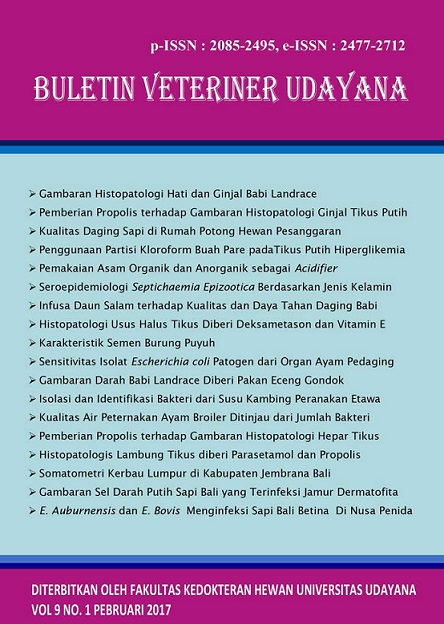HISTOPATHOLOGICAL STUDY ON WHITE RATS’ GASTRIC GIVEN PARACETAMOL AND PROPOLIS SUPPLEMENTATION
Abstract
Propolis is a substance produced by bees that has some benefits, such as: antioxidants and antiulkus. Paracetamol is a relatively safe drug for gastric, but in some studies claimed that high doses of paracetamol increase the risk of gastric mucosal disorders, such as: ulceration, desquamation, and erosion. The purpose of this study is to determine the effects of propolis in histopathological gastric rats that were given high doses of paracetamol. This study used a completely randomized design. A sample of 25 male rats were divided into 5 groups i.e.: a negative control without treatment paracetamol (P0), a positive control (P) that was given paracetamol 250 mg/kgbw, and three other groups given treatment with paracetamol 250 mg/kgbw with a variation of propolis, P1 (0.05 ml/rat), P2 (0.10 ml/rat), and P3 (0.15 ml/rat). The treatment was given in 10 days, then necropsy was done and gastric organs were taken. Histologic gastric specimen for histopathological examination was made by using the Kiernan method (1990) and stained with hematoxylin eosin (HE). Variables examined include histopathological lesions of erosion, desquamation, and ulceration of the gastric epithelium. Results indicate that in treatment P severe damage to the gastric (desquamation) has occurred, while the entire treatment P1, P2, and P3 show the repair from the damage caused by the paracetamol. Treatment P3 gives the best results in reducing the effects of the paracetamol. This study concluded that the provision of propolis may reduce the histopathological side effects on white rat’s gastric givenhigh dose of paracetamol.
Downloads
References
Atmaja D. 2008. Pengaruh ekstrak kunyit (Curcuma domestica) terhadap gambaran mikroskopik mukosa lambung mencit balb/c yang diberi parasetamol. semarang. Karya tulis ilmiah Fakultas Kedokteran Universitas Diponegoro.
Duarte J, Galisteo M, Angeles-Ocete M, Pérez-Vizcaino F, Zarzuelo A, Tamargo J. 2001. Effects of chronic quercetin treatment on hepatic oxidative status of spontaneously hypertensive rats. J Pharmacol 133(1): 117-124.
Gheldof N, Wang XH, Engeseth NJ. 2002. Identification and quantification of antioxidant components of honeys from various floral sources. J Agric Food Chem 50: 5870-5877.
Kiernan JA. 1990. Histology and histochemical Methods: teory and practice. 2nd Ed. Oxford: Pergamon Press.
Kumar V, Abbas AK, Fausto N. 2005. Pathologic basis of desease. 7th Ed. Elsevier inc. Philadelphia.
Marcucci MC, Ferreres F, Viguera GC, Bankova VS, De Castro SL, Dantas AP, Valente PHM, Paulino N. 2001. Phenolic compounds from Brazilian propolis with pharmacological activities. J Ethnopharmacol 74: 105-120.
Nakajima Y, Tsuruma K, Shimazawa M, Mishima S, Hara H. 2009. Comparison of bee products based on assays of antioxidant capacities. Nagaragawa Research Center. Department of Biofunctional Evaluation, Molecular Pharmacology, Gifu Pharmaceutical University, 5-6-1 Mitahora-higashi, Gifu 502-8585. Japan. J BioMed Cent Med 4(9): 1472-1482.
Suastika P. 2011. Efek pemberian buah merah (Pandanus conoideus) terhadap perubahan histopatologik ginjal dan hati mencit pasca pemberian paracetamol. Bul Vet Udayana 3(1): 39-44.
Viuda MV, Ruiz NY, Fernández LJ, Pérez ÁJ. 2008. Functional properties of honey, propolis, and royal jelly. J Food Sci 73: 117-124.
Wiralaga IPA, IW Sudira, IM Kardena, AAGO Darmayudha. 2015. Pengaruh pemberian ekstrak etanol daun ashitaba terhadap histopatologi lambung mencit jantan. Bul Vet Udayana 7(1): 26-33.





